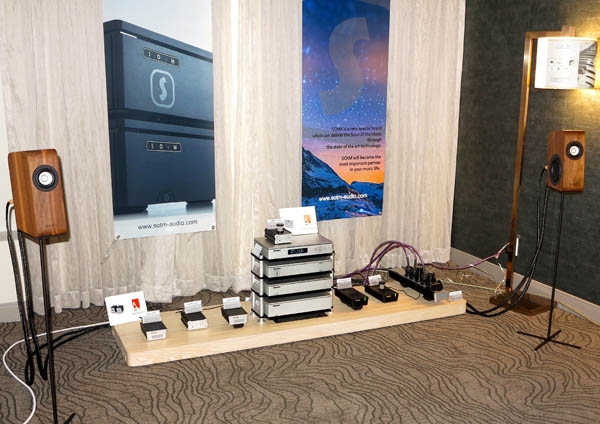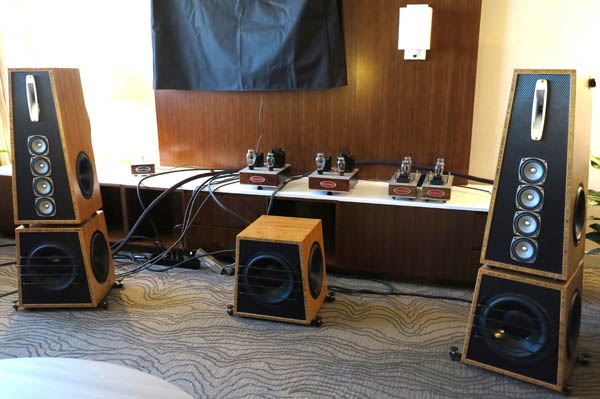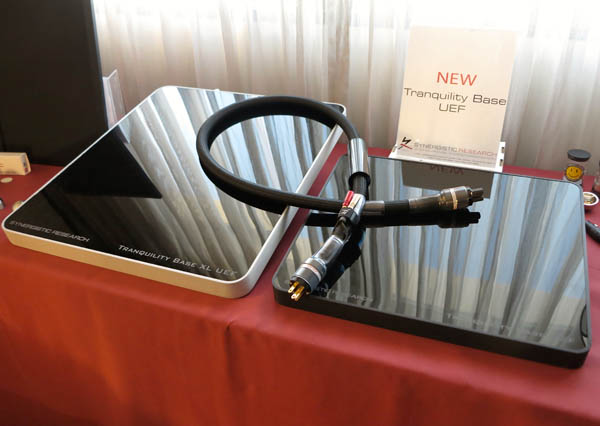| Columns Retired Columns & Blogs |
You guys should get your days straight. Today is WEDNESDAY, not FRIDAY........unless one of us is living in an alternate universe!

The remarkably compact Boenicke W5 Special Edition loudspeakers ($4500/pair) were fed by an entire SOtM array, including cabling, with the addition of a Nordost entry-level Purple Flair power cord ($170). SOtM's contributions included the mBPS-d2s, which goes on the back of the USB output of the sMS-1000SQ Eunhasu music player ($3500 up depending upon configuration) and does something I cannot figure out from the notes that were sent me; sDP-1000EX DAC/preamp ($3500); sPS-1000 200Wpc Class D power amp, not yet officially released ($3500); sPS-1000 low-noise linear power supply ($1000); forthcoming tX-USBUltra USB audio signal regenerator ($TBD); forthcoming sPS-500 hybrid power supply ($TBD); the US version of the forthcoming mT-1000 power strip ($TBD); and the aforementioned cabling.
I loved the sound of Arne Domnéras and Gustav Sjokvist's "Antiphone Blues" and Arthur Fiedler's Hungarian Rhapsody No.2. Not only was the performance extremely musical, with timbres convincingly neutral and believable, but it was also mind-blowingly spacious and three-dimensional. It's hard to believe that such diminutive speakers can descend to 42Hz. Sven Boenicke, who has to be one of the handsomest, most soft-spoken men in high-end audio, told me that the SE version of the W5 in the room has a better bass driver and tuning devices, as well as better crossover components, than the regular W5.
The system owed at least part of its amazing spaciousness, depth, and expanse to the eight Bybee Room Neutralizers hanging on the walls. I have six of these in my listening room, and am now determined to get two more. I remain amazed how these babies, along with the Stein Harmonizers, affect the listening environment and make it more three-dimensional and alive. Check out the link above, and be sure to read Jack's response to a query from Kal Rubinson in the comments section of that show blog. For readers who think outside the box, Jack tells me that the Swiss/German MAXiiMUS 16 from Kemp Electronics is another atmosphere-affecting product to check out.

Although I found the sound in the Wavelength Audio/Vaughn Loudspeakers room totally engaging—it was very spacious and warm, with fast bass and a lively top—it seems the system was operating under an extreme handicap. Gordon Rankin's prototype Wavelength Europa 71A directly-heated triode preamp ($7500) was trashed in transit, necessitating an emergency loan of VAC's new Renaissance Mk 5 preamp ($9,900). On Saturday, Jim Jordan of Vaughn replaced the VAC with his own overnighted Wavelength Renaissance MKV preamp ($17,000). It was only at that time, after people had settled down from scramble-induced panic, that speaker issues could be addressed, and all parties felt that the system was performing optimally. Perhaps Herb Reichert, who visited the room during that period, can comment upon the sound below.
What I can tell you is that everyone heard, in addition to one or another preamp, a MacBook Pro Retina 15 16G/480GSSD Thunderbolt; a 4T Drobo SSD RAID array library source; Wavelength's Crimson + Q1 FPGA DoP/PCM DAC module ($9000) or Cosecant + Quotient FPGA DoP/PCM DAC Module ($4000); Wavelength's new limited-edition all-silver Napoleon Ag Silver ($35,000/pair), Corona V2 VT52 Silver ($20,000/pair), or Cardinal Classic ($5000/pair) amplifiers; Vaughn Plasma Signature Edition loudspeakers with Duquesne plasma tweeters ($20,000/pair); and lots of AudioQuest cabling. If all the "or"s and "and"s in the above leaves you confused—who the hell knows what was playing, let alone if Mrs. Goldberg's laundry had dried by show time—imagine how I felt as three different people were sending me emails containing different information about the equipment that was not included on the USB stick handed to me in the room.

Margules Audio, which has been involved in the audio industry in Mexico in one capacity or another for a whopping 98 years, showed a host of products. When I entered the room, the Magenta TT-10 turntable ($2700) and DAC-2.1 ($899) joined the Margules U280 Black Edition class-A amplifier ($4900) and SF220 Black Edition preamplifier ($3700) to feed truly beautiful sound through Margules Orpheus loudspeakers ($12,000/pair) via Atlas cables from Scotland.
From the ubiquitous Reference Recordings Mephisto & Co LP—please see my October issue editorial—I thankfully heard a track seldom played. Liszt's Mephisto Waltz No.1. The liquidity was paramount, and the strings more real-sounding than in a lot of rooms. A hi-rez track of Felix Heil playing Bach on the organ showed this equipment is not afraid to convey highs, and does not roll off the top end. "Tube warmth without calling undue attention to itself," I wrote in my notes.
When we turned up the volume in the small room, control remained supreme. I've praised Margules equipment in the past, and my positive assessment remains. So does my curiosity as to how the more expensive electronics that I did not have time to hear would have sounded.

Both times I passed the Synergistic Research/Scott Walker active room on the 5th floor, it was packed to the gills, with the door locked for every-half-hour demos. While I did return on slow, slow Sunday, at which time I enjoyed success—that report is to come—I learned in the adjacent room that the new Synergistic Research Tranquility Base UEF ($2250, or $2995 for the extra-large version) now contains graphene superconductor material and UEF technology (see their website for more information). Since I use two of the older Tranquility Bases and one Tranquility Basik (discontinued) in my system, and have discovered that they significantly reduce noise and make the sound maximally transparent, I immediately expressed interest in trying out the new versions.
Also new are handmade Atmosphere Series active-shielding AC cables, most of which do their thing without need of a ground. They also include custom UEF calibration and active shield filters. All I can tell you about all that is to quote someone whom I overheard talking to a friend by the elevators: "I don't know what the hell is in those things, but I sure heard a difference."
By the time I had left the room, it was time after the 7 pm show close. I immediately poised myself to make a mad dash up the stairs to the Wes Phillips Memorial Gathering in the big PS Audio room on the 11th floor. Then it was on to the slow elevators for another sprint across the road to the Hilton, where I was able to stay for part of the awards ceremony. By the time I made it out of there and reached the restaurant where we were dining, it was at least 8:30 pm. And what did I discover there but two videos that we were invited to watch before we ordered dinner! That's with a day that began with a 9am strategy meeting at breakfast!

You guys should get your days straight. Today is WEDNESDAY, not FRIDAY........unless one of us is living in an alternate universe!

is discussing what they saw LAST Friday, which was Day 1 of the RMAF show.

Love the spirit and candor of your show reviews Jason. Thanks for sharing. And appreciate your calling out the Bybee and Stein products. They are the type of product that often incites online attack. Great that you call it like you hear it.
I live in a tropical environment - Hawaii rainforest. On rare days when it's cool, clear, dry, I notice improvements in my system similar to what you describe the Bybee and Stein products. On those days, the air is different, and the change has an impact. Look forward to trying out Bybee and/or Stein at some point down the road.